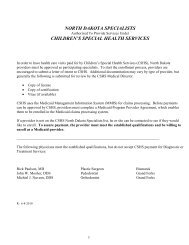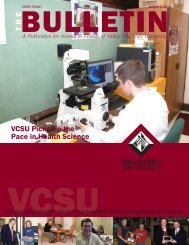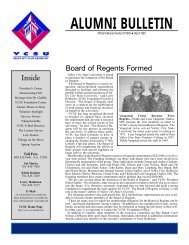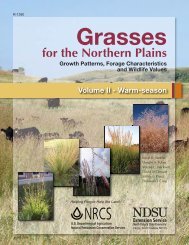EERCECONOMIC IMPACT - North Dakota State Library
EERCECONOMIC IMPACT - North Dakota State Library
EERCECONOMIC IMPACT - North Dakota State Library
Create successful ePaper yourself
Turn your PDF publications into a flip-book with our unique Google optimized e-Paper software.
University of<br />
<strong>North</strong> <strong>Dakota</strong><br />
Grand Forks<br />
EERC ECONOMIC <strong>IMPACT</strong><br />
EERC Technology – Putting Research into Practice<br />
The EERC has an estimated regional impact of more than $90 million.
Creating Opportunities<br />
The Energy & Environmental Research Center<br />
(EERC) at the University of <strong>North</strong> <strong>Dakota</strong><br />
(UND) is recognized internationally for its<br />
expertise in the development, demonstration,<br />
and commercialization of advanced energy<br />
systems and pollution prevention and cleanup<br />
technologies for air, water, and soil.<br />
Established as a federal research and development<br />
facility in 1951, the EERC has been part of UND since<br />
1983 when it was defederalized by the U.S. Department of<br />
Energy (DOE). Today, the EERC is recognized as one of the<br />
world’s leading developers of energy and environmental technologies.<br />
Director<br />
Gerald Groenewold<br />
Through its development of<br />
innovative, practical solutions<br />
to today’s pressing energy and<br />
environmental problems, Director<br />
Gerald Groenewold says<br />
the EERC is helping the area<br />
economy grow. “The Center is<br />
one of the best examples in this<br />
region of new wealth creation.”<br />
Because of the entrepreneurial,<br />
market-driven culture of the<br />
EERC, its impact on the regional<br />
economy is substantial. The<br />
EERC has fostered the creation<br />
of several new businesses in the Grand Forks region that are<br />
based on technology and expertise developed at the EERC. It<br />
also commercializes innovative technologies and processes<br />
through partnerships with private industry; local, state, and<br />
federal government; and the research community.<br />
Poised for Further Growth<br />
Opportunities in the energy and environmental arenas are<br />
dynamic, and the EERC expects rapid growth in the very near<br />
future. As a result of the EERC’s National Center for Hydrogen<br />
Technology (NCHT), numerous private industry partners<br />
have committed to developing new business and manufacturing<br />
opportunities in the state as technologies are developed,<br />
which will lead to hundreds of new, high-quality technical jobs.<br />
Because of highly strategic Centers of Excellence programs that<br />
address critical worldwide energy and environmental issues,<br />
the EERC expects to grow to more than 550 employees within<br />
the next 5 to 7 years.<br />
Global Partnerships<br />
The EERC is international in scope. It has established working<br />
relationships with numerous organizations from all corners of<br />
the globe and attracted them to the Grand Forks area. Since<br />
1987, the EERC has had over 1000 clients in 50 countries and all<br />
50 states, involving individual contracts and multiclient consortia<br />
with private industry, federal and state agencies, and academic<br />
institutions. In FY07, over 84% of the EERC’s contracts were with<br />
private sector clients. The EERC averages over 2000 visitors a<br />
year, which include many international and student groups.<br />
The EERC's new 15,000-square-foot facility for the National Center for Hydrogen<br />
Technology is expected to augment hydrogen-related programmatic growth,<br />
resulting in 50 to 100 new high-paying technical jobs at the EERC and facilitating<br />
at least 50 to 100 new private sector jobs in the Grand Forks region.<br />
A Resource for Jobs<br />
While pursuing its mission to address critical technical<br />
issues, solve problems, and help society, the EERC provides<br />
environmentally friendly, high-tech jobs that pay well. “It’s a<br />
shame that we provide our children with quality educations,<br />
only to have them leave the state,” Groenewold says. “The<br />
economic future of this region depends on the types of jobs the<br />
EERC is providing.”<br />
The EERC employs an exceptionally talented and diverse group<br />
of people whose work attracts business from around the world.<br />
While people from all corners of the globe can be found at the<br />
EERC, nearly 80% of its employees come from <strong>North</strong> <strong>Dakota</strong><br />
and Minnesota, and 60% of degreed employees are graduates of<br />
the <strong>North</strong> <strong>Dakota</strong> University System.<br />
One of the biggest employers in the Grand Forks region, the<br />
EERC gives the region's young professionals a good reason to<br />
live and work in a place they call home.<br />
Within the next 2 years, the EERC will be providing direct and<br />
indirect employment for approximately 1200 people in the<br />
greater Grand Forks area (using the U.S. Department of Commerce’s<br />
Regional Input–Output Modeling System II formula).<br />
According to DOE, the 16 coal and power projects currently<br />
under way at the EERC are worth a total of $120 million and<br />
provide approximately 3423 direct and indirect jobs regionwide.
Student Employment<br />
At any point in time, the EERC employs more than 30 students from<br />
UND and other academic institutions, ranging from undergraduates<br />
to postdoctorates. Students have come from across the nation and<br />
many countries throughout the world, including the Czech Republic,<br />
Poland, India, Ukraine, China, Germany, France, South Africa,<br />
and Russia, to take advantage of the opportunity to gain firsthand<br />
experience with the Center’s team of scientists and engineers.<br />
EERC Facts<br />
History<br />
1951 – Established as U.S. Bureau of Mines Robertson Lignite<br />
Research Laboratory.<br />
1977 – Designated as one of five Energy Technology Centers<br />
with DOE.<br />
1983 – Defederalized.<br />
– Facilities given to University of <strong>North</strong> <strong>Dakota</strong>.<br />
– Renamed UND Energy Research Center.<br />
1989 – Renamed UND Energy & Environmental Research Center.<br />
EERC Professionals<br />
Chemistry<br />
Analytical Chemistry<br />
Applied Chemistry<br />
Biochemistry<br />
Electrochemistry<br />
Environmental Chemistry<br />
Fuel Chemistry<br />
Geochemistry<br />
Hydrochemistry<br />
Inorganic Chemistry<br />
Organic Chemistry<br />
Physical Chemistry<br />
Process Chemistry<br />
Engineering<br />
Aerospace Engineering<br />
Agricultural Engineering<br />
Biochemical Engineering<br />
Chemical Engineering<br />
Civil Engineering<br />
Electrical Engineering<br />
Electrochemical Engineering<br />
Energy Engineering<br />
Engineering Management<br />
Environmental Engineering<br />
Geological Engineering<br />
Industrial and Management<br />
Engineering<br />
Mechanical Engineering<br />
Petroleum Engineering<br />
Sanitary Engineering<br />
Thermal Engineering<br />
Sciences<br />
Anthropology<br />
Applied Physics<br />
Archeology<br />
Bacteriology<br />
Biology<br />
Biomedical Research<br />
Computer Science<br />
Earth Science<br />
Environmental Biology<br />
Environmental Microbiology<br />
Environmental Geology<br />
Environmental and Natural<br />
Resources<br />
Environmental Science<br />
Fuel Science<br />
Geography<br />
Geohydrology<br />
Geological Sciences<br />
Geology<br />
Geophysics<br />
Hydrogeology<br />
Material Science<br />
Mathematics<br />
Microchemistry<br />
Microbiology<br />
Mineralogy<br />
Natural Sciences<br />
Paleontology<br />
Petroleum Geology<br />
Physical Science<br />
Physics<br />
Theoretical Physics<br />
Water Resource Management<br />
1994 – $7.6 million expansion of labs and pilot plant facilities<br />
completed.<br />
1997 – April flooding of the Red River forces the EERC to close<br />
for 20 days.<br />
– EERC flood damages estimated to $40 to $45 million in<br />
lost equipment and business.<br />
1998 – EERC laboratories damaged in flood become fully<br />
operational.<br />
1999 – Annual contract awards exceed $11 million.<br />
2000 – Annual contract awards exceed $15 million.<br />
2001 – Celebrated 50 years of innovative energy and<br />
environmental research.<br />
2002 – Broke ground on $8 million addition/renovation.<br />
2003 – 47,000-square-foot expansion and renovation project<br />
opens. Annual contract awards exceed $17.5 million.<br />
2004 – Annual contract awards exceed $26.5 million.<br />
2005 – Annual contract awards exceed $29 million.<br />
2006 – Contract awards exceeded $45 million in fourth<br />
consecutive record year.<br />
Broke ground for new 15,000-square-foot hydrogen facility.<br />
2007 – Proposal number exceeds 300, valued at over $138 million.<br />
Other Disciplines<br />
Accounting<br />
Architectural Drafting<br />
Business<br />
Business Administration<br />
Communications<br />
Community Counseling<br />
Computer Information<br />
Systems<br />
Economics<br />
Education<br />
Electric Construction<br />
Electronics Technology<br />
Energy Resources<br />
English<br />
English Literature<br />
Environmental Technology<br />
Fine Arts<br />
French<br />
General Agriculture<br />
German<br />
History<br />
Humanities<br />
Industrial/Organizational<br />
Psychology<br />
Industrial Technology<br />
Information Systems<br />
Information Technology<br />
Law<br />
Legal Assistance<br />
<strong>Library</strong> Science<br />
Management<br />
Management Information<br />
Systems<br />
Marketing<br />
Microcomputers/Networking<br />
Nursing<br />
Office Administration<br />
Photography<br />
Political Science<br />
Psychology<br />
Reading Education<br />
Refrigeration/Air Conditioning<br />
Research Methodologies<br />
Secretarial<br />
Speech<br />
Technology Assessment and<br />
Management<br />
Television<br />
Travel and Tourism<br />
Visual Arts<br />
Technical Expertise<br />
and Capabilities<br />
Administrative Assistants<br />
Certified Welders<br />
Computer Programmers<br />
Database Analysts<br />
Database Managers<br />
Electrician<br />
Electronic Technicians<br />
Financial Analysts<br />
Graphic Designers<br />
Instrumentation Technicians<br />
Machinists<br />
Machine Tool and Die<br />
Metallurgists<br />
Technical Editors<br />
Technology Demonstration<br />
Unit Operators
Economic Impact<br />
Contracts<br />
• In FY07, the EERC had 442 active contracts, of which 84%<br />
were with private sector clients.<br />
Employment<br />
• Total employment of over 300 scientists, engineers, and<br />
support personnel, including 20 full-time-equivalent<br />
employees supported elsewhere on UND campus.<br />
• 57% of employees are from <strong>North</strong> <strong>Dakota</strong>.<br />
• 21% of employees are from Minnesota.<br />
• 53% of degreed employees are graduates of UND.<br />
• 60% of degreed employees are graduates of the <strong>North</strong> <strong>Dakota</strong><br />
University System.<br />
Travel<br />
• $1 million a year spent on travel. The EERC fosters personal<br />
relationships with its clients.<br />
Visitors<br />
• An average of three groups a week.<br />
• The EERC averages more than 2000 visitors a year, which<br />
include many international visitors and students (preschool<br />
through university).<br />
• Total expenditures in FY07 were at more than $27 million, with<br />
an estimated regional impact of more than $94.5 million.<br />
EERC Summary<br />
Philosophy and Mission<br />
To improve global quality of life by providing leadership in<br />
visionary multidisciplinary research and development leading to<br />
the demonstration and commercialization of innovative, clean,<br />
and efficient energy and environmental technologies addressing<br />
the protection of air, water, and soil worldwide.<br />
The EERC emphasizes true working partnerships between<br />
private industry, government agencies, academic institutions,<br />
and the research community. By fostering private sector<br />
partnerships from the initiation of a research and development<br />
program, the opportunities for technology commercialization<br />
are dramatically enhanced.<br />
Area Hometowns of<br />
EERC Staff<br />
Crosby<br />
Bottineau<br />
Hallock Lancaster Warroad<br />
Lake Bronson<br />
Kennedy<br />
Belcourt<br />
Cando<br />
Stephen International Falls<br />
Williston<br />
Berthold<br />
Rugby Lawton<br />
Drayton Newfolden<br />
Inkster<br />
Minot<br />
Manvel<br />
Petersburg<br />
Thief River Falls<br />
Devils Lake Lakota Grand Forks<br />
Warren<br />
Oklee<br />
Velva<br />
Larimore<br />
Drake<br />
Thompson East Grand Forks<br />
Parshall Max<br />
<strong>North</strong>wood<br />
Crookston<br />
Bisbee Aneta Reynolds<br />
Bemidji<br />
Buxton<br />
Golden Valley<br />
Binford Mayville Ada Mahnomen<br />
Dickinson<br />
Deadwood<br />
Rapid City<br />
Programs<br />
Advanced Power and Energy Systems<br />
Energy Conversion System Optimization<br />
Environmental Chemistry<br />
Environmental Control Technologies (particulates, air toxic<br />
metals, SO x , NO x , and CO 2 )<br />
Fossil Energy Resources (oil, gas, and coal)<br />
Hydrogen Production, Distribution, and Fuel Cell Technology<br />
Renewable Energy<br />
Waste Utilization, Management, and Site Remediation<br />
Water Management (availability, contaminant remediation, and<br />
flood and drought protection)<br />
Centers of Excellence<br />
Coal Utilization Technologies Center<br />
Emission Control Technologies Center<br />
The National Center for Hydrogen Technology (NCHT)<br />
Center for Climate Change and CO 2 Sequestration<br />
Center for Air Toxic Metals® (CATM®)<br />
Centers for Renewable Energy and Biomass Utilization<br />
Water Management Center<br />
National Alternative Fuels Laboratory® (NAFL®)<br />
Supercritical and Subcritical Extraction Technologies Center<br />
Coal Ash Research Center<br />
For More Infromation Contact:<br />
Energy & Environmental Research Center<br />
15 <strong>North</strong> 23rd Street, Stop 9018<br />
Grand Forks, ND 58202-9018<br />
Phone: (701) 777-5000<br />
Fax: (701) 777-5181<br />
www.undeerc.org<br />
Gerald H. Groenewold, Director<br />
Phone: (701) 777-5131<br />
E-mail: ghg@undeerc.org<br />
Deb J. Haley, Associate Director, Marketing, Outreach, and<br />
Administrative Resources<br />
Phone: (701) 777-3120<br />
E-mail: dhaley@undeerc.org<br />
Valley City<br />
New Salem<br />
Fargo<br />
Mandan Jamestown<br />
Moorhead<br />
West Fargo<br />
Bismarck<br />
Elgin<br />
Streeter Edgley<br />
Pelican Rapids<br />
Flasher<br />
La Moure<br />
Lidgerwood<br />
Wahpeton<br />
Aberdeen<br />
Andover<br />
Sioux Falls<br />
Hoffman<br />
Willmar<br />
Lake Lillian<br />
Alexandria<br />
Brainerd<br />
Minneapolis<br />
Eden Prairie<br />
Bloomington<br />
St.<br />
Paul<br />
Duluth<br />
Hoyt Lakes<br />
Winona<br />
7/08


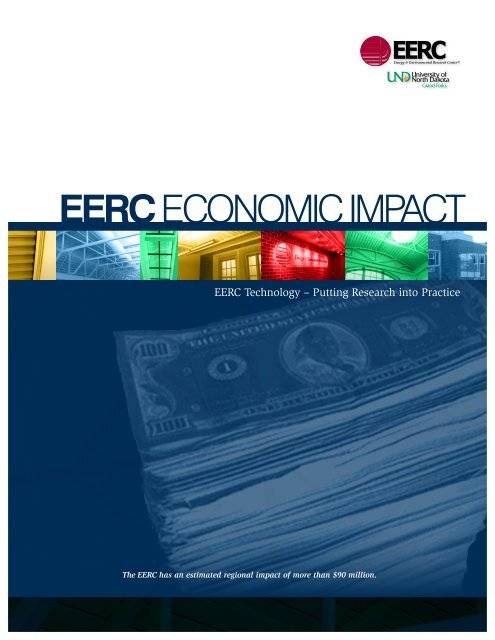
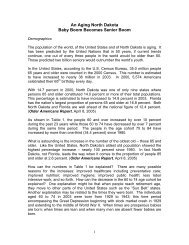
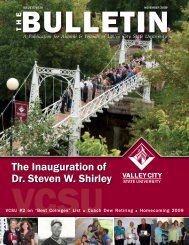
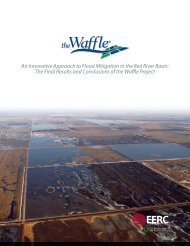
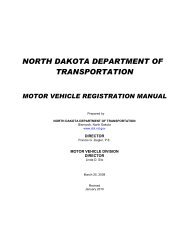
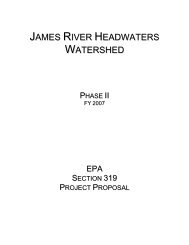
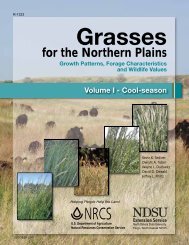
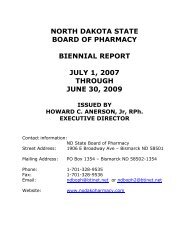
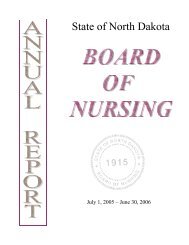

![T:\...\Wind Energy PanAer [PFP#1100138798] - North Dakota State ...](https://img.yumpu.com/17808731/1/190x245/twind-energy-panaer-pfp1100138798-north-dakota-state-.jpg?quality=85)
